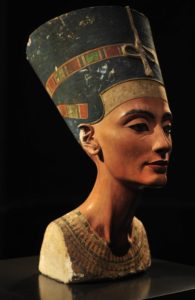Nefertiti lived and reigned during the 14th century BCE as a Queen of Egypt and the wife of Pharaoh Amenhotep IV. While her birth place remains unconfirmed, her origins are believed to be have been in Syria. Her husband Pharaoh Amenhotep had reinvented himself as Akhenaton during the 5th year of his reign, out of respect for the god Aten. They ruled together between 1353-1341BCE and had 6 daughters together, one of whom was Ankhesenamun. Ankhesenamun is known for being the wife and half-sister of the famous Pharaoh Tutankhamun.
The name ‘Nefertiti’ translates to “a beautiful woman has come”, which is appropriate as she was renowned in ancient Egypt for both her beauty and sexuality. She wore her own unique headdress which is visible in the 1912 archaeological find of her bust. This headdress is tall, straight edged, blue and has a flat top. Her clothes would have been made from a fine linen which exaggerated her feminine body. The 6 princesses were said to have followed her where she walked, in order to establish her as a living deity.
By the end of 1348 BCE, Egyptian religion had become Monotheistic as the Pharaoh had declared that there was only one god deserving worship. This god was Aten, who was an aspect of the previous solar deity Ra who had been worshipped in Egypt for centuries. Unlike other deities, Aten did not take the form of a human or animal and was instead depicted as a sun disk with extended hands that reached to earth. The only way you could worship this god was through his priests; Pharaoh Akhenaton and Nefertiti. As a mark of respect, she too changed her name to Neferneferuaten-Nefertiti which meant “beautiful are the beauties of Aten, a beautiful woman has come”. This change to Monotheism meant that the state temples were closed and a new capital was created in honour of Aten; Akhetaton, now known as Amarna. This city thrived during the reign of Akhenaton, however on his death the city was abandoned.
Akhenaton and Nefertiti were also known for their changes in artistic design, which can you can see in images from their temples. These show the royal family portrayed in a natural style, rather than the common formal. The reliefs show the Pharaoh and his Queen to be almost inseparable, as they are often depicted riding in chariots and kissing. These actions have lead scholars to believe that Nefertiti and Akhenaton had a real love for each other. Such a relationship was not commonly seen in royal partnerships as they predominantly arose from duty. Her appearance in chariots has also led some to question whether Nefertiti was acting as Queen Regnant rather than a consort. If so, this would establish her as a co-ruler, rather than a Queen Consort. This is further evidenced by the discovery of images in Karnak which show her participating in the smiting of female enemies.
In 1341BCE Nefertiti vanished from all images and state records. The most logical explanation for this is her death, but there is no record of this. There is also no evidence that she was buried with her family in the royal tomb in Amarna.  In 1912 her bust was discovered and has remained on display in the Egyptian Museum in Berlin since the 1920’s. This image is one of the most recognisable images from ancient Egypt and in fact, all of the ancient world. Nefertiti is fascinating as if we believe the artistic depictions that have been recovered, she could have been a co-ruler of a great Pharaoh and a warrior in her own right. At the very least, she goes down in Egyptian history as a high priestess of the cult of Aten and a descendant of the infamous pharaoh Tutankhamun.
-Devon Allen
Junior Girl
Girl Museum Inc.

